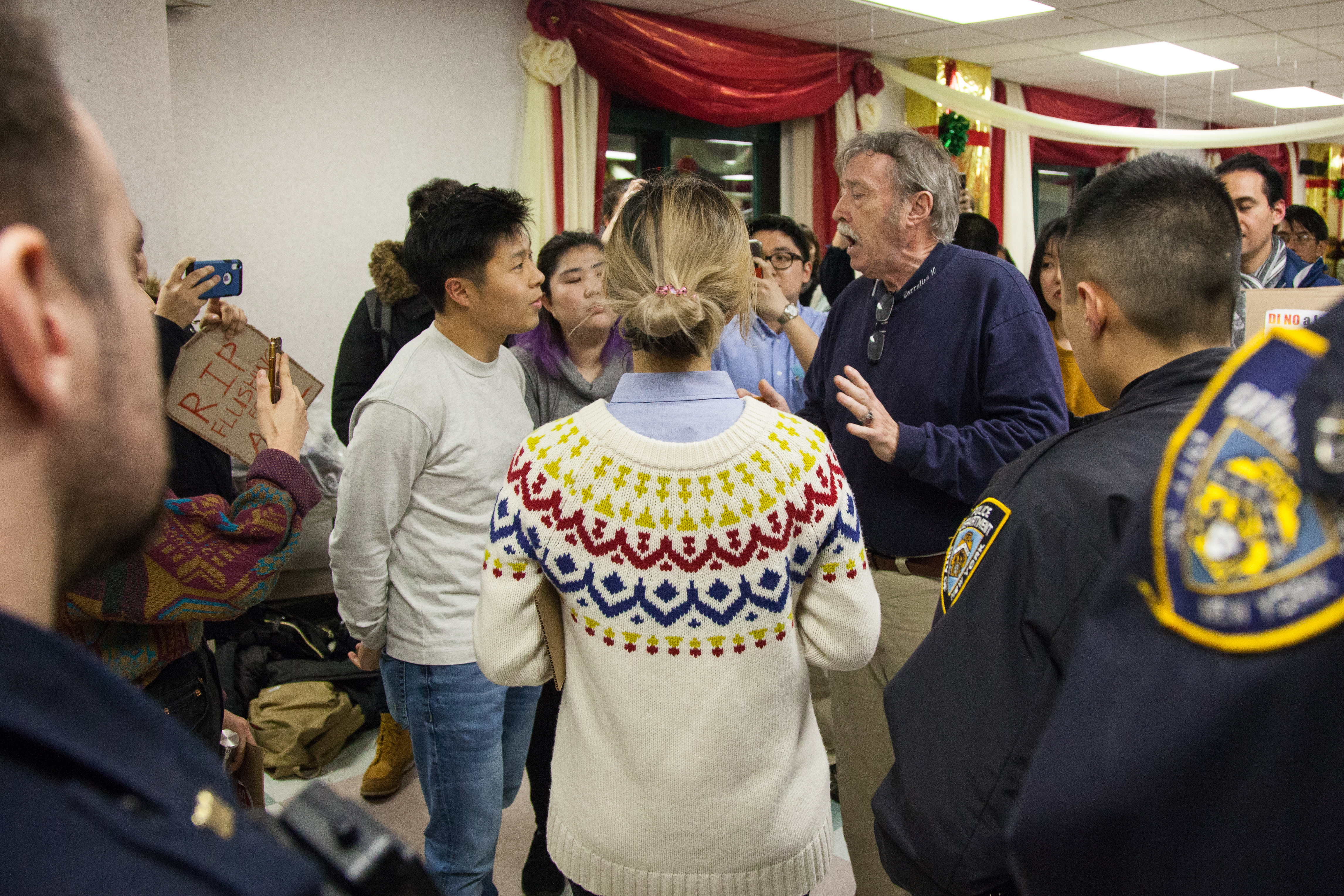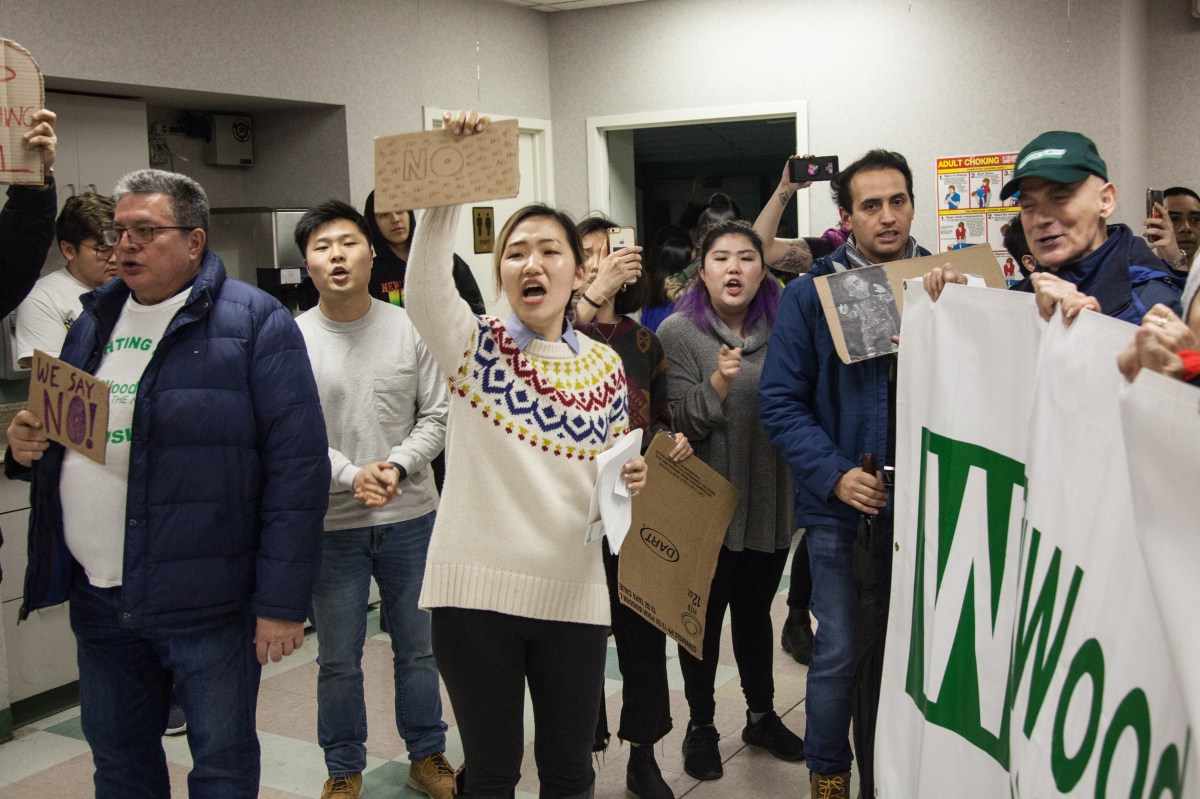Queens Community Board 7’s public hearing over the Special Flushing Waterfront District on Monday night turned into a drawn-out, 4 ½-hour affair as protestors against the rezoning fought to have their voices heard within the structure of the meeting.
Tensions boiled over as hundreds of residents — the majority of whom opposed the plan — packed into the Union Plaza Care Center. In the middle of a two-hour presentation on the plan, protesters and two community board leaders clashed in such a manner that police had to intervene.
Once things calmed down following an interruption, the board resumed with public testimony from all who signed up — then cast an overwhelming 30-8 vote (with one abstention) recommending approval of the project. Nevertheless, even those who supported the special waterfront district raised some fundamental concerns with the plan.
The plan would create a 29-acre waterfront district that would lead to the construction of 1,725 new apartments, 879 new hotel units, a new road system, an open waterfront path, offices, retail and community center space. The developers say it would offer between 75 and 90 units of affordable housing.
Procedural problems
The hearing began with a raucous rally outside the nursing home where CB 7 meets, led by labor and tenant unions 32BJ and the Minkwon Center, among other community groups. They urged the board to vote against the plan and consider alternatives on the basis of its environmental impacts.
As the meeting got underway, members of the crowd raised concerns that the agenda only scheduled 15 minutes of public testimony, while community board representatives and developers were allotted two hours for presentations. About 45 people had signed up to speak — it’s estimated that 30 of them opposed the district — and they worried they wouldn’t have a chance to speak.
At one point, CB 7 Chairperson Eugene Kelty confronted the agitated protestors for making too much noise. This led to a shouting match during which Kelty reached to grab a phone of a protester who was filming him. This led to 109th Precinct officers intervening to make sure it didn’t escalate further.

Moments later, when Land Use Committee Chair Joe Sweeney tried to diffuse the situation, he and another protester got too physically close. Cops had to separate them as well.
After taking a brief moment to cool off, CB 7 decided to alter the prescribed agenda in order to allow community members to talk right away.
Heated testimony
The testimony largely split between community members associated with the MinKwon Center, unions and environmentalists who opposed the rezoning, and local business owners who supported it as an opportunity.
Though the developers framed the vote as a choice between the public benefits of a rezoning, and as-of-right development with none, several of the opponents said they would not support the project without an Environmental Impact Statement (EIS), a detailed city report that analyzes the effects of a rezoning.
“No rigorous study on its environmental impact nor of its impact of gentrification and racialized housing displacement have been made,” said David Lee, a staffer for Assemblyman Ron Kim.
Many of the MinKwon protesters, a group composed to a great extent of local teenagers from immigrant households, spoke about how they felt that their communities were not consulted by the developers or community board.
“Community Board 7 does not represent the 14,000-plus Chinese immigrants living in Flushing. I’m here because the Chinese working-class residents who lack English proficiency, such as my family, could not make it,” said Yuriko Zhang, a 17-year-old protester.
On the other hand, several of the developers small business owners, though fewer in numbers than their opponents, spoke about their own background as immigrants.
“I came to this country with nothing but my bare hands,” said John Liang, president of YNG, one fo the proposed developers. “We go to school, we contribute to this country and we earn our right to stay.”
Todd Leong of Leaf Cocktail Bar and Lounge described the rezoning as an opportunity for young Flushing residents.
“It’s a project like this that will create jobs. I employ 20 people, all of them Flushing residents – many of them very young,” said Leong. “They are all able to put themselves through college.”
Conflicted Community Board
When the community board began to deliberate, several of its members echoed the concerns of the opponents, which included traffic congestion, the developer’s lack of commitment to providing union jobs, real estate speculation and lack of community input.

“There really has been a serious lack of input from organized community stakeholders,” said Community Board Fourth Vice Chair Lei Zhao.
Kelty responded that the Community Board is always open to working with local groups who approach them. Another member, however, argued that the advisory body should have proactive about communicating with MinKwon Center.
Vice Chair Chuck Apelian, who recused himself of a vote as a result of consulting work for the project’s developers, gave an impassioned speech arguing that the developers will inevitably build, with or without community approval.
“The big key and why I got involved in this project is because the infrastructure goes off College Point Boulevard through the site over to Roosevelt instead of jamming up Roosevelt Avenue,” said Apelian.
Community board votes are recommendations; the final say on rezoning plans rests with the City Planning Commission and the City Council.
After suffering a brief bout of indecision and coming very close to tabling the vote, the community board voted in favor of approving the rezoning with an extensive list of recommendations, which focus on vehicular traffic, environmental impacts and a school construction study.
The board’s advisory vote will next go to acting Borough President Sharon Lee, who has 30 days to submit a recommendation.




































